Wall Mosaics: A Review of On-Site Non-Invasive Methods, Application Challenges and New Frontiers for Their Study and Preservation
Abstract
1. Introduction
2. Wall Mosaic Characteristics and Main Diagnostic Challenges
2.1. Structural Layering
2.2. Presence of Inhomogeneities
2.3. Limited Accessibility
3. Some Examples of Applications of Non-Invasive Methods to Study Wall Mosaics
3.1. Ground Penetrating Radar (GPR)
3.2. Infrared Thermography (IRT)
3.3. Complementary On-Site Non-Invasive Methods
3.4. In-Situ Results
3.5. Laboratory Simulation Studies
4. Conclusions and Future Directions
Author Contributions
Funding
Conflicts of Interest
References
- Waterman, A.E. A History of Mosaics; Hacker Art Books: New York, NY, USA, 1968. [Google Scholar]
- King, S. Mosaic Techniques and Traditions: Projects and Designs from around the World; Stirling Publishing Co. Inc.: New York, NY, USA, 2003. [Google Scholar]
- Fabbri, B. Science and Conservation for Museum Collections; Nardini: Firenze, Italy, 2012. [Google Scholar]
- Masini, N.; Soldovieri, F. Integrated non-invasive sensing techniques and geophysical methods for the study and conservation of architectural, archaeological and artistic heritage. J. Geophys. Eng. 2011, 8, 083E01. [Google Scholar] [CrossRef]
- Lerma, C.; Gil Benso, E.; Mas, Á.; Vercher, J.; Torner, M. Non-destructive techniques methodologies for the detection of ancient structures under heritage buildings. Int. J. Archit. Herit. 2019. [Google Scholar] [CrossRef]
- Fais, S.; Casula, G.; Cuccuru, F.; Ligas, P.; Bianchi, G. An innovative methodology for the non-destructive diagnosis of architectural elements of ancient historical buildings. Sci. Rep. 2018, 8, 4334. [Google Scholar] [CrossRef] [PubMed]
- Sala, R.; Tamba, R.; Garcia, E. Application of geophysical methods to cultural heritage. Elements 2012, 12, 19–25. [Google Scholar] [CrossRef]
- Cozzolino, M.; Di Giovanni, E.; Mauriello, P.; Piro, S.; Zamuner, D. Book Geophysical Methods for Cultural Heritage; Springer International Publishing Switzerland AG: Cham, Switzerland, 2018. [Google Scholar]
- Cosentino, P.; Capizzi, P.; Fiandaca, G.; Martorana, R.; Messina, P. Advances in microgeophysics for engineering and cultural heritage. J. Earth Sci. 2009, 20, 626–639. [Google Scholar] [CrossRef]
- Fiorentini Roncuzzi, I.; Fiorentini, E. Mosaic: Materials, Techniques and History; MWeV: Ravenna, Italy, 2002. [Google Scholar]
- Farneti, M. Glossario Tecnico-Storico del Mosaico: Con Una Breve Storia del Mosaico; Longo: Ravenna, Italy, 1993. [Google Scholar]
- Henig, M.; Ithaca, N.Y. A Handbook of Roman Art: A Comprehensive Survey of All the Arts of the Roman World; Cornell University Press: Ithaca, NY, USA, 1983. [Google Scholar]
- Demus, O. Byzantine Mosaic Decoration: Aspects of Monumental Art in Byzantium; Routledge & Kegan Paul: London, UK, 1948. [Google Scholar]
- Cilento, A. The Mosaics of Norman Sicily; Magnus Edizioni: Reggio Emilia, Italy, 1950. [Google Scholar]
- Demus, O. The Mosaics of San Marco in Venice; University of Chicago Press: Chicago, IL, USA, 1984; pp. 358, 495. [Google Scholar]
- Mouriki, D.; Burgi, R. The Mosaics of the New Chios Monastery (Ditomo), Byzantine Monuments; Commercial Bank of Greece publisher: Athens, Greece, 1985. (In Greek) [Google Scholar]
- Martinho, E.; Dionísio, A. Main geophysical techniques used for non-destructive evaluation in cultural built heritage: A review. J. Geophys. Eng. 2014, 11, 1–15. [Google Scholar] [CrossRef]
- Santos-Assunçao, S.; Perez-Gracia, P.; Caselles, O.; Clapes, J.; Salinas, V. Assessment of complex masonry structures with gpr compared to other non-destructive testing studies. Remote Sens. 2014, 6, 8220–8237. [Google Scholar] [CrossRef]
- Cosentino, P.L.; Capizzi, P.; Martorana, R.; Messina, P.; Schiavone, S. From geophysics to microgeophysics for engineering and cultural heritage. Int. J. Geophys. 2011, 2011, 428412. [Google Scholar] [CrossRef][Green Version]
- Ranalli, D.; Scozzafava, M.; Tallini, M. Ground penetrating radar investigations for the restoration of historic buildings: The case study of the Collemaggio Basilica (L’Aquila, Italy). J. Cult. Herit. 2004, 5, 91–99. [Google Scholar] [CrossRef]
- Barone, P.M.; Di Matteo, A.; Graziano, F.; Mattei, E.; Pettinelli, E. GPR application to the structural control of historical buildings: Two case studies in Rome, Italy. Near Surf. Geophys. 2006, 407–413. [Google Scholar] [CrossRef]
- D’Aranno, P.J.V.; De Donno, G.; Marsella, M.; Orlando, L.; Renzi, B.; Salviani, S.; Santarelli, M.L.; Scifoni, S.; Sonnessa, A.; Verri, F.; et al. High-resolution geomatic and geophysical techniques integrated with chemical analyses for the characterization of a Roman wall. J. Cult. Herit. 2015, 141–150. [Google Scholar] [CrossRef]
- Daniels, D.J. Ground Penetrating Radar, 2nd ed.; IEE: London, UK, 2004; ISBN 0-86341-360-9. [Google Scholar]
- Reynolds, J.M. An Introduction to Applied and Environmental Geophysics; Wiley-Blackwell: Hoboken, NJ, USA, 2011. [Google Scholar]
- Candoré, J.C.; Bodnar, J.L.; Detalle, V.; Grossel, P. Non-destructive testing of works of art by stimulated infrared thermography. Eur. Phys. J. Appl. Phys. 2012, 57, 21002. [Google Scholar] [CrossRef]
- Mercuri, F.; Orazi, N.; Paoloni, S.; Cicero, C.; Zammit, U. Pulsed thermography applied to the study of cultural heritage. Appl. Sci. 2017, 7, 1010. [Google Scholar] [CrossRef]
- Vallet, J.-M.; Detalle, V.; De Luca, L.; Bodnar, I.-L.; Guillon, O.; Trichereau, B.; Mouhoubi, K.; Martin-Beaumont, N.; Syvilay, D.; Giovannacci, D.; et al. Development of a NDT toolbox dedicated to the conservation of wall paintings: Application to the frescoes chapel in the Charterhouse of Villeneuve-lez-Avignon (France). Digit. Herit. 2013, 67–74. [Google Scholar] [CrossRef]
- Jo, Y.H. Study on Applicability of Passive Infrared Thermography Analysis for Blistering Detection of Stone Cultural Heritage. The korean society of conservation science for cultural properties. J. Conserv. Sci. 2013, 29, 55–67. [Google Scholar] [CrossRef][Green Version]
- Paoletti, D.; Ambrosini, D.; Sfarra, S.; Bisegna, F. Preventive thermographic diagnosis of historical buildings for consolidation. J. Cult. Herit. 2013, 14, 116–121. [Google Scholar] [CrossRef]
- Sfarra, S.; Ibarra-Castanedo, C.; Theodorakeas, P.; Avdelidis, N.P.; Perilli, S.; Zhang, H.; Nardi, I.; Koui, M.; Maldague, X.P. Evaluation of the state of conservation of mosaics: Simulations and thermographic signal processing. Int. J. Therm. Sci. 2017, 117, 287–315. [Google Scholar] [CrossRef]
- Sfarra, S.; Ibarra-Castanedo, C.; Tortora, M.; Arrizza, L.; Cerichelli, G.; Nardi, I.; Maldague, X.P. Diagnostics of wall paintings: A smart and reliable approach. J. Cult. Herit. 2016, 18. [Google Scholar] [CrossRef]
- Titman, D.J. Applications of thermography in non-destructive testing of structures. NDT&E Int. 2001, 34, 149–154. [Google Scholar] [CrossRef]
- Maldague, X.P. Theory and Practice of Infrared Technology for Nondestructive Testing; Wiley-Interscience: Hoboken, NJ, USA, 2001; ISBN 978-0-471-18190-3. [Google Scholar]
- Grinzato, E. IR thermography applied to the cultural heritage conservation. J. Appl. Sci. 2017, 7, 1010. [Google Scholar]
- Mercuri, F.; Zammit, U.; Orazi, N.; Paoloni, S.; Marinelli, M.; Scudieri, F. Active infrared thermography applied to the investigation of art and historic artefacts. J. Therm. Anal. Calorim. 2011, 104, 475. [Google Scholar] [CrossRef]
- Côte, P.; Abraham, O. Seismic Tomography in Civil Engineering; NDT-CE: Berlin, Germany, 1995; pp. 459–466. [Google Scholar]
- Athanasiou, E.; Tsourlos, P.; Tsokas, G.; Papazachos, C.; Vargemezis, G. Nondestructive DC resistivity surveying using flat base electrodes. Near Surf. Geophys. 2009, 5, 263–272. [Google Scholar] [CrossRef]
- Cosentino, P.L.; Capizzi, P.; Fiandaca, G.; Martorana, R.; Messina, P.; Amoroz, R. Integrated full 3D geoelectrical and GPR Tomographies in the ambulatory of the Roman “Villa del Casale” (Piazza Armerina). In Proceedings of the 14th European Meeting of Environmental and Engineering Geophysics, Krakow, Poland, 15–17 September 2008. [Google Scholar] [CrossRef]
- Paoletti, D.; Schirripa Spagnolo, G. Interferometric methods for artwork diagnostics. Prog. Optics 1996, XXXV, 197–255. [Google Scholar] [CrossRef]
- Lokberg, O.J. Electronic speckle pattern interferometry. Phys. Technol. 1980, 11, 16–22. [Google Scholar] [CrossRef]
- Vest, C.M. Holographic Interferometry; John Wiley and Sons, Inc.: Hoboken, NJ, USA, 1979. [Google Scholar]
- Jones, R.; Wykes, C. Holographic and Speckle Interferometry, 2nd ed.; Cambridge Press: Cambridge, UK, 1989. [Google Scholar]
- Kosma, K.; Andrianakis, M.; Hatzigiannakis, K.; Tornari, V. Digital holographic interferometry for cultural heritage structural diagnostics: A coherent and a low-coherence optical set-up for the study of a marquetry sample. Strain 2018, 54. [Google Scholar] [CrossRef]
- Tornari, V. Optical and digital holographic interferometry applied in art conservation structural diagnosis. E-Preserv. Sci. 2006, 3, 51–57. [Google Scholar]
- Tornari, V. On development of portable digital holographic speckle pattern interferometry system for remote-access monitoring and documentation in art conservation. Strain 2019, 201. [Google Scholar] [CrossRef]
- Tornari, V.; Tsiranidou, E.; Bernikola, E. Interference fringe-patterns association to defect-types in artwork conservation: An experiment and research validation review. Appl. Phys. A 2012, 106, 397–410. [Google Scholar] [CrossRef]
- Tornari, V.; Bernikola, E.; Nevin, A.; Kouloumpi, E.; Doulgeridis, M.; Fotakis, C. Fully non contact holography-based inspection on dimensionally responsive artwork materials. Sensors 2008, 8, 8401–8422. [Google Scholar] [CrossRef]
- Tornari, V.; Bernikola, E.; Tsigarida, N.; Andrianakis, M.; Hatzigiannakis, K.; Leissner, J. Preventive deformation measurements on cultural heritage materials based on non-contact surface response of model samples. Stud. Conserv. 2015, 60, S143–S158. [Google Scholar] [CrossRef]
- Tornari, V.; Andrianakis, M.; Hatzigiannakis, K.; Kosma, K.; Detalle, V.; Bourguignon, E.; Giovannacci, D.; Brissaud, D. Complimentarity of digital holographic speckle pattern interferometry and simulated infrared thermography for cultural heritage structural diagnostic research. Int. J. Eng. Res. Sci. (IJOER) 2016, 2, 129–141. [Google Scholar]
- Chaban, A.; Tornari, V.; Andrianakis, M.; Deiana, R. Comparison of induced thermal change to climate chamber simulated environmental change in mosaic model by digital holographic speckle pattern interferometry (DHSPI). SPIE 110580I 2019. [Google Scholar] [CrossRef]
- Tornari, V.; Bonarou, A.; Castellini, P.; Esposito, E.; Osten, W.; Kalms, M.; Smyrnakis, N.; Stasinopulos, S. Laser based systems for the structural diagnostic of artworks: An application to XVII century Byzantine icons. In Proceedings of the Laser Techniques and Systems in Art Conservation, Munich, Germany, 22 October 2001; Volume 4402. [Google Scholar]
- Drain, L.E. The Laser Doppler Technique; Lincoln: John Wiley & Sons: Hoboken, NJ, USA, 1980. [Google Scholar]
- Castellini, P.; Esposito, E.; Paone, N.; Tomasini, E.P. Non-invasive measurements of damage of frescoes paintings and icon by laser scanning vibrometer: Experimental results on artificial samples and real works of art. Measurement 2000, 28, 33–45. [Google Scholar] [CrossRef]
- Razevig, V.V.; Ivashov, S.I.; Vasiliev, I.A.; Zhuravlev, A.V.; Bechtel, T.; Capineri, L.; Falorni, P. RASCAN holographic radars as means for non-destructive testing of buildings and edificial structures. In Proceedings of the Structural Faults and Repair-2010, Edinburgh, Scotland, UK, 15–17 June 2010. [Google Scholar]
- Ivashov, S.I.; Makarenkov, V.I.; Masterkov, A.V.; Razevig, V.V.; Sablin, V.N.; Sheyko, A.P.; Tchapourski, V.V.; Vasiliev, I.A. Concrete floor inspection with help of subsurface radar. In Proceedings of the 6th Meeting Environmental and Engineering Geophysics, Bochum, Germany, 3–7 September 2000. [Google Scholar]
- Ivashov, S.; Razevig, V.; Sheyko, A.; Vasilyev, I.; Zhuravlev, A.; Bechtel, T. Holographic subsurface radar technique and its applications. In Proceedings of the 12th International Conference on Ground-Penetrating Radar, GPR 2008, Birmingham, UK, 16–19 June 2008. [Google Scholar]
- Capineri, L.; Falorni, P.; Borgioli, G.; Bulletti, A.; Valentini, S.; Ivashov, S.; Zhuravlev, A.; Razevig, V.; Vasiliev, I.; Paradiso, M.; et al. Application of the RASCAN holographic radar to cultural heritage inspections. archaeol. Prospect 2009, 16, 218–230. [Google Scholar] [CrossRef]
- Capineri, L.; Falorni, P.; Ivashov, S.; Zhuravlev, A.; Vasiliev, I.; Razevig, V.; Bechtel, T.; Stankiewicz, G. Combined holographic subsurface radar and infrared thermography for diagnosis of the conditions of historical structures and artworks. Eur. Geosci. Union Gen. Assem. 2009, 11, EGU2009-5343-2. [Google Scholar] [CrossRef]
- Razevig, V.V.; Zhuravlev, A.V.; Bugaev, A.S.; Chizh, M.A.; Ivashov, S.I. Imaging under irregular surface using microwave holography. In Progress in Electromagnetics Research Symposium—Fall (PIERS-FALL); IEEE: Piscataway, NJ, USA; pp. 172–177. [CrossRef]
- Mainstone, R.J. Hagia Sophia. Architecture, Structure and Liturgy of Justinian’s Great Church; Thames & Hudson: London, UK, 1997. [Google Scholar]
- Moropoulou, A.; Avdelidis, N.P.; Delegou, E.T.; Aggelakopoulou, E.; Karoglou, M.; Haralampopoulos, G.; Griniezakis, S.; Koui, M.; Karmis, P.; Aggelopoulos, A.; et al. NDT Investigation on Hagia Sophia Mosaics, in Research Work; NTUA: Athens, Greece, 2000. [Google Scholar]
- Moropoulou, A.; Bakolas, A.; Karoglou, M.; Delegou, E.T.; Labropoulos, K.C.; Katsiotis, N.S. Diagnostics and protection of hagia sophia mosaics. J. Cult. Herit. 2013, 14S, 133–139. [Google Scholar] [CrossRef]
- Moropoulou, A.; Labropoulos, K.C.; Katsiotis, N.S. Assessing the preservation state and revealing plastered mosaics in hagia sophia using ground penetrating radar. J. Mater. Sci. Eng. 2012, 2, 183–189. [Google Scholar]
- Moropoulou, A.; Avdelidis, N.P.; Aggelakopoulou, E.; Griniezakis, S.; Koui, M.; Aggelopoulos, A.; Karmis, P.; Uzunoglou, N.K. Examination of plastered mosaic surfaces using NDT techniques. Insight Non-Destr. Test. Cond. Monit. 2001, 43, 241–243. [Google Scholar]
- Moropoulou, A.; Avdelidis, N.P.; Delegou, E.T.; Aggelakopoulou, E.; Karoglou, M.; Haralampopoulos, G.; Griniezakis, S.; Koui, M.; Karmis, P.; Aggelopoulos, A.; et al. Investigation for the compatibility of conservation interventions on Hagia Sophia mosaics using NDT techniques. J. Eur. Study Group Phys. Chem. Biol. Math. Tech. Appl. Archaeol. Athens 2000, 59, 103–120. [Google Scholar]
- Theodorakeas, P.; Cheilakou, E.; Ftikou, E.; Koui, M. Passive and active infrared thermography: An overview of applications for the inspection of mosaic structures. 33rd UIT Ital. Union Fluid Dyn. Heat Transf. Conf. 2015, 655. [Google Scholar] [CrossRef]
- Theodorakeas, P.; Koui, M. Quantitative infrared thermography for the investigation of plastered mosaics: Comparison of experimental results and numerical modelling. In Proceedings of the 9th International Symposium on the Conservation of Monuments in the Mediterranean Basin, Ankara, Turkey, 3–5 June 2014; pp. 431–445. [Google Scholar]
- Delinikolas, N.; Miltiadou-Fezans, A.; Chorafa, E.; Zaroyianni, E. Restoration Study of the Katholikon of Dafni Monastery, Phase A-Architectural and Historical Survey; Hellenic Ministry of Culture: Athens, Greece, 2003.
- Côte, P.; Dérobert, X.; Miltiadou-Fezans, A.; Delinikolas, N.; Durand, O.; Alexandre, J.; Kalagri, A.; Savvidou, M.; Chryssopoulos, D.; Anamaterou, L.; et al. Application of non-destructive techniques at the katholikon of dafni monastery for mapping the mosaics substrata and grouting monitoring. In Structural Analysis of Historic Construction; D’Ayala, D., Fodde, E., Eds.; Taylor and Francis: London, UK, 2007; pp. 1149–1156. [Google Scholar]
- Fiandaca, F.; Martorana, R.; Messina, P.; Cosentino, P. 3D ERT for the study of an ancient wall covered by precious mosaics. In Proceedings of the Near Surface 15th European Meeting of Environmental and Engineering Geophysics, Dublin, Ireland, 7–9 September 2009. [Google Scholar] [CrossRef]
- Schirripa, S.G.; Ambrosini, D.; Paoletti, D. Optical methods for mosaic diagnostics. J. Opt. 1998, 29, 394–400. [Google Scholar]
- Theodorakeas, P.; Ibarra-Castanedo, C.; Sfarra, S.; Avdelidis, N.P.; Koui, M.; Maldague, X.P.; Paoletti, D.; Ambrosini, D. NDT inspection of plastered mosaics by means of transient thermography and holographic interferometry. NDT E Int. 2012, 47, 150–156. [Google Scholar] [CrossRef]
- Chaban, A.; Tornari, V.; Deiana, R.; Andrianakis, M.; Giovannacci, D.; Detalle, V. A combined non-invasive approach to the study of a mosaic model: First laboratory experimental results. J. Imaging 2019, 5, 58. [Google Scholar] [CrossRef]
- Garrido, I.; Lagüela, S.; Sfarra, S.; Zhang, H.; Maldague, X.P. Automatic detection and delimitation of internal moisture in mosaics from thermographic sequences. Exp. Tests Proc. 2019, 27, 7. [Google Scholar] [CrossRef]
- Chaban, A. Non-Invasive Methods for the Study of Wall Decorations in Art History and Archaeology. Ph.D. Thesis, University of Padua, Padua, Italy, 2019. [Google Scholar]
- Castellini, P.; Esposito, E.; Marchetti, B.; Paone, N.; Tomasini, E.P. New applications of Scanning Laser Doppler Vibrometry (SLDV) to non-destructive diagnostics of artworks: Mosaics, ceramics, inlaid wood and easel painting. J. Cult. Herit. 2003, 4, 321s–329s. [Google Scholar] [CrossRef]

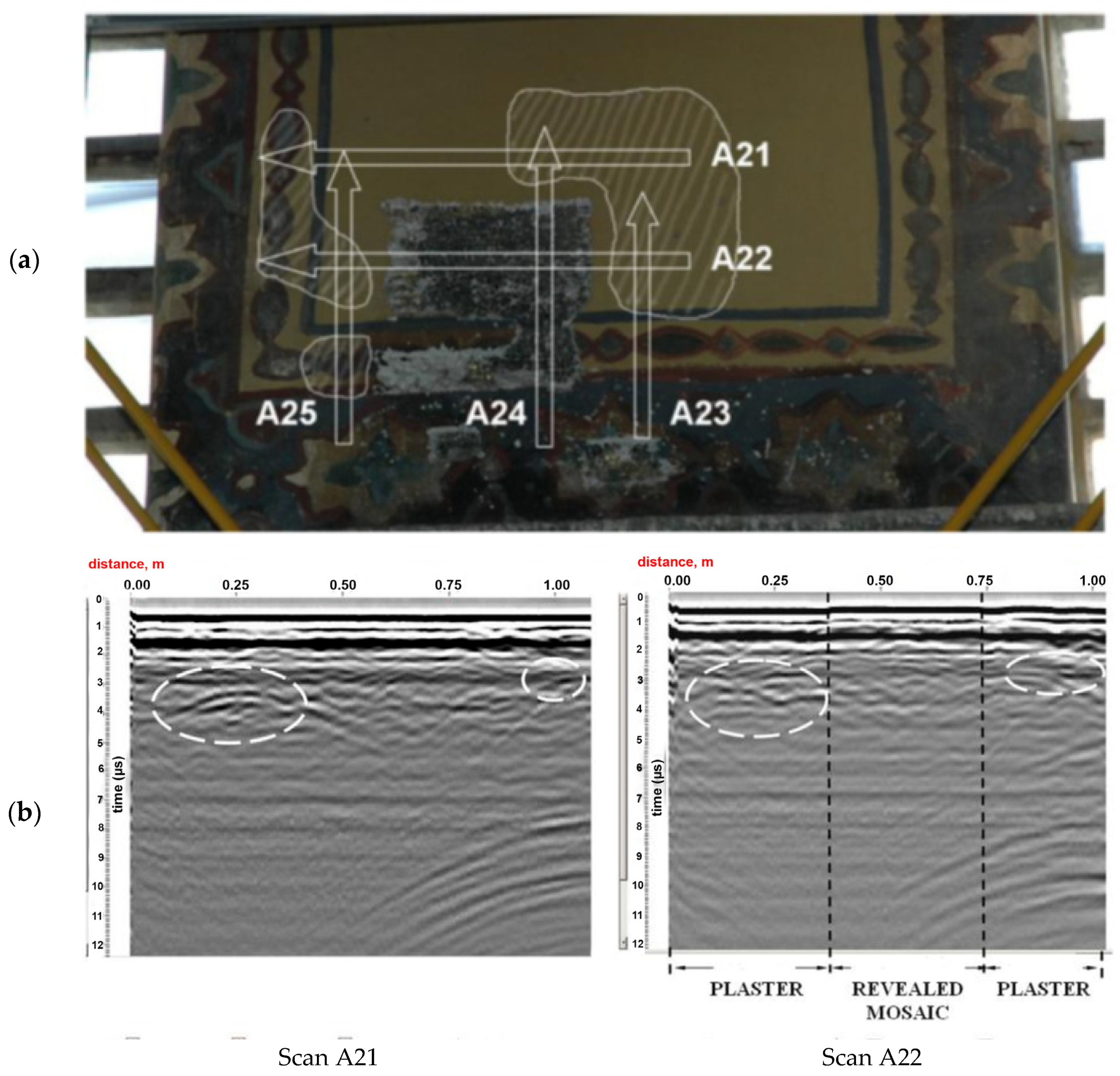
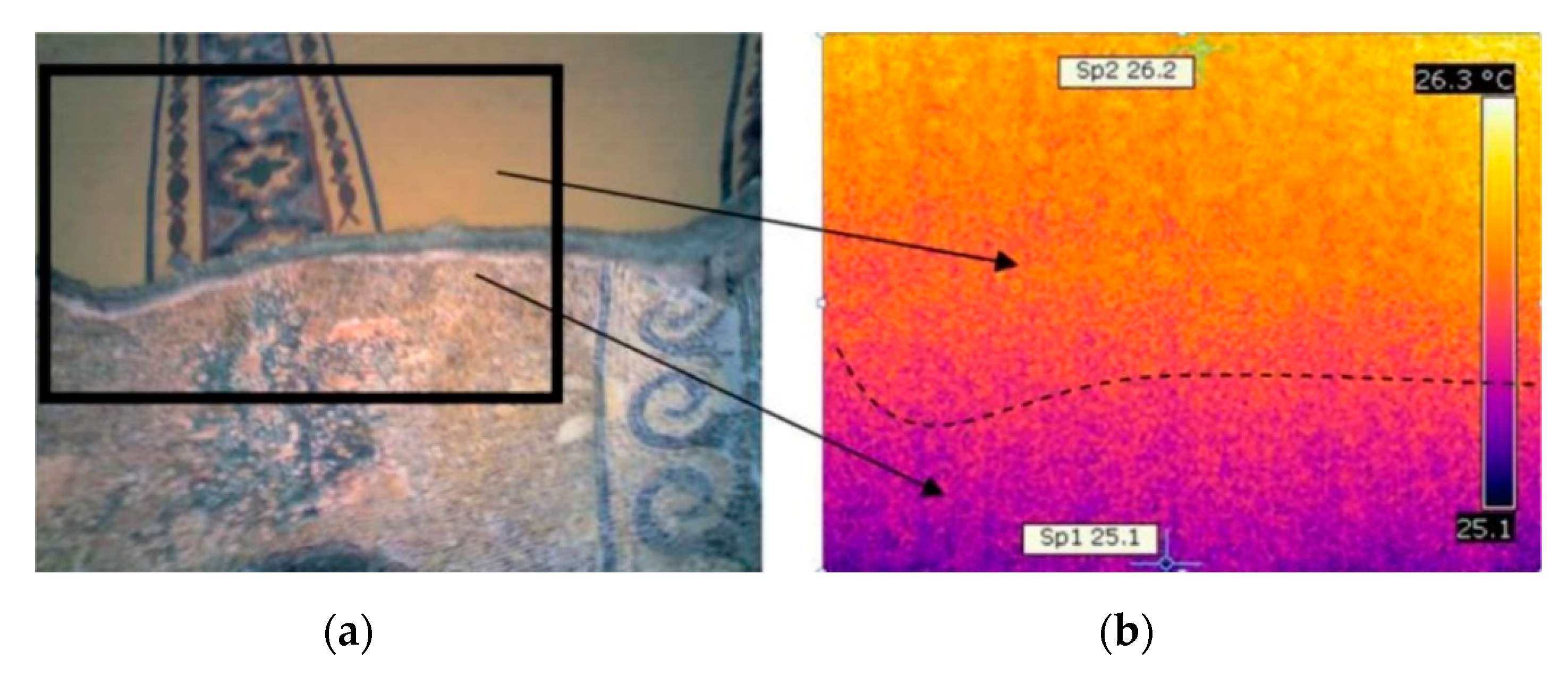
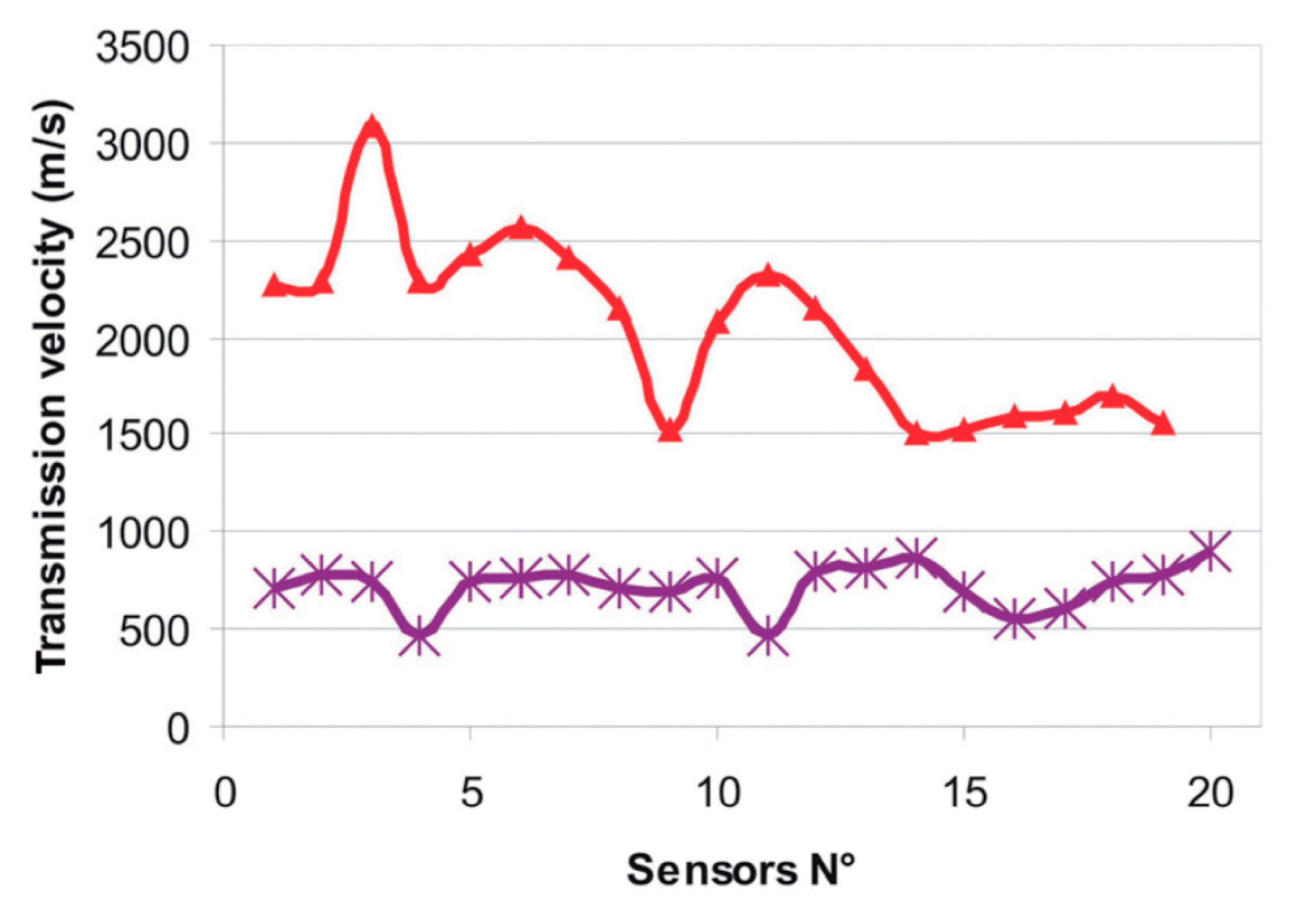

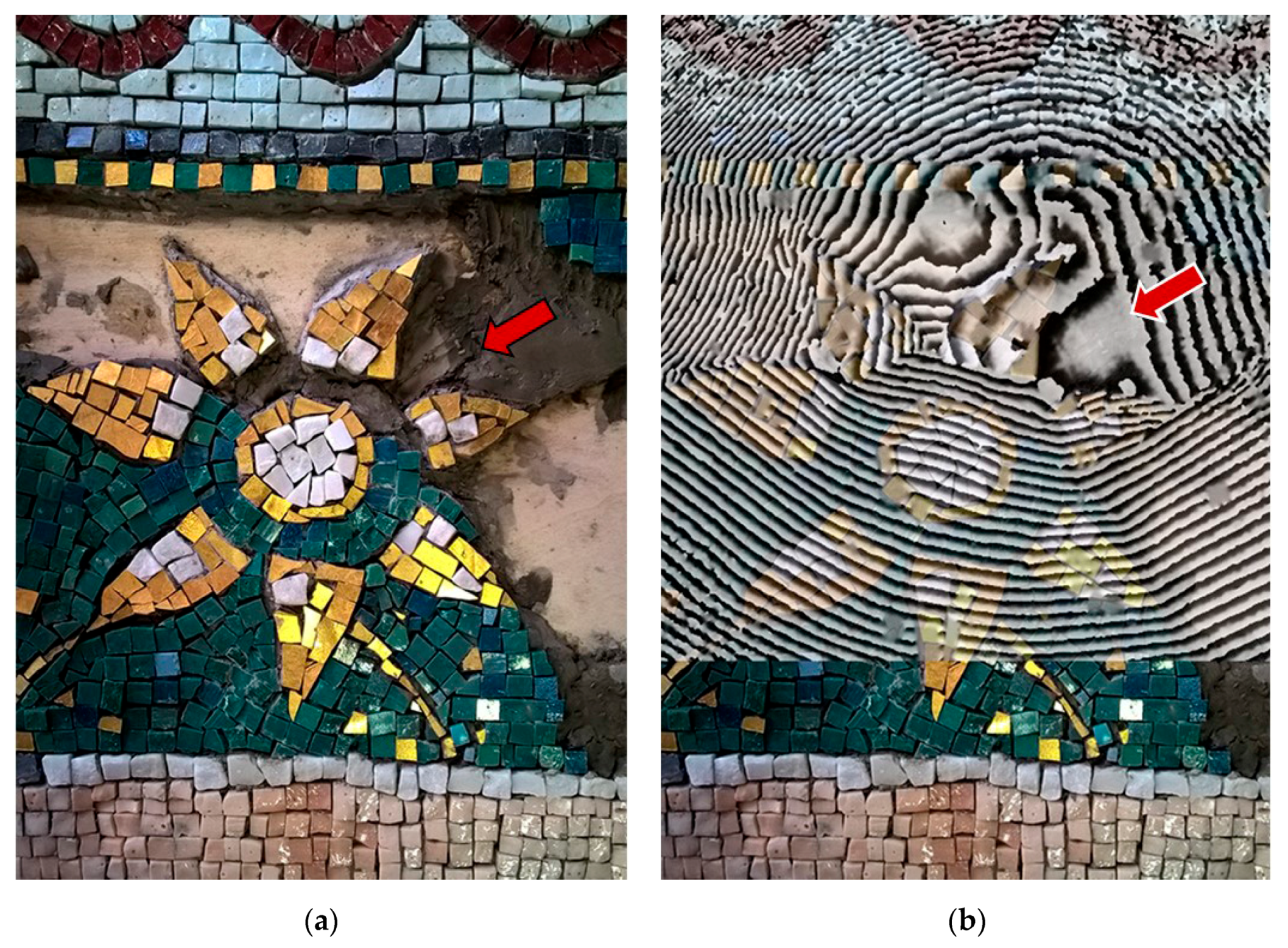

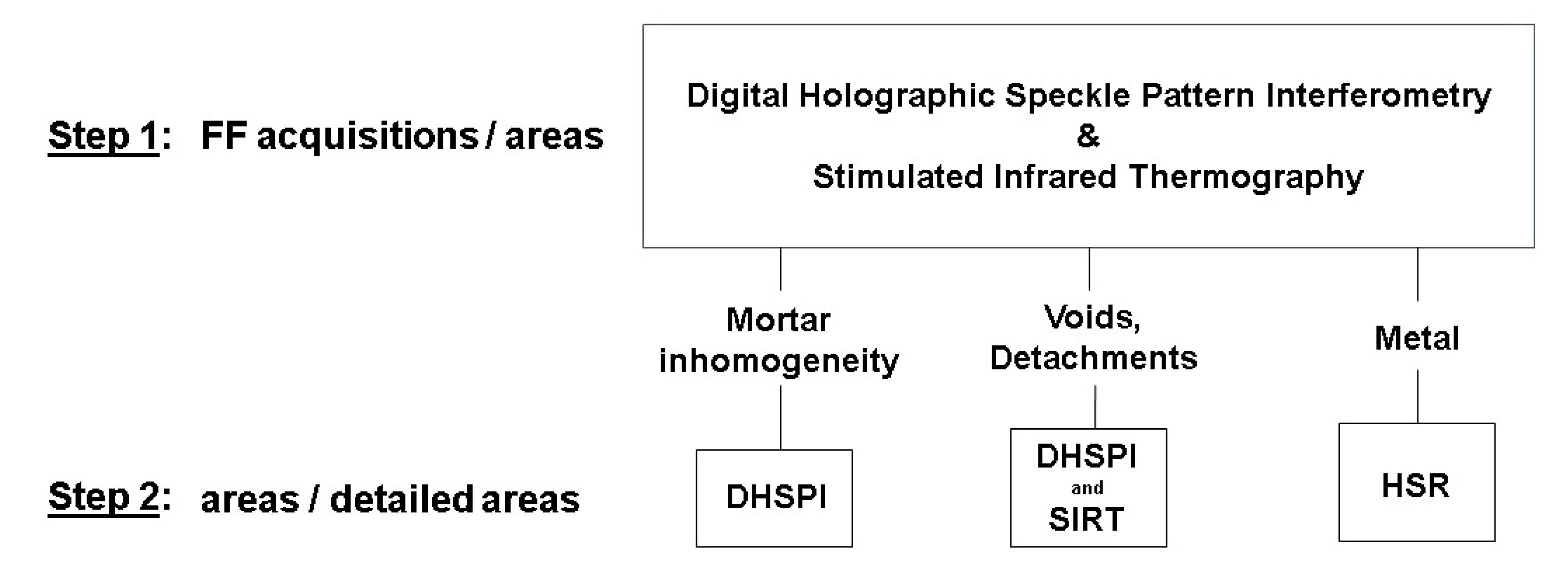


| Methods | Characteristics | Applicability | Resolution | Case Studies, Lab Tests on Wall Mosaics * (References) | ||||
|---|---|---|---|---|---|---|---|---|
| Portable | Non-Contact | Full-Field | Irregular, Inhomogeneous Surfaces | Gold Leaf Tesserae | Shallow Depth | Deep Structure | ||
| GPR | + | − | − | +/− | − | +/− | + | [61,62,63,64,65,69] |
| IRT/SIRT | + | + | + | + | − | + | +/− | [61,62,64,65,66,67,72,73,74,75] |
| DHSPI/DHSPI-SIRT | + | + | + | (+) | (+) | (+) | o | [73,75] |
| HSR | + | − | − | (−) | (−) | (+) | o | [73,75] |
| ERT | + | − | − | + | + | + | +/− | [70] |
| acoustic | + | − | − | + | o | + | + | [69] |
| SLDV | + | + | − | (+) | o | (+) | o | [76] |
| other (MI/FOM) | + | + | +/− | + | + | − | − | [61,62,75] |
| Methods | Achievements and Advantages | Limitations and Issues to Solve |
|---|---|---|
| GPR | Optimal technique for revealing deep wall structural defects, possibility of quantitative analysis (depth target estimation) | Contact operation, line acquisition, low resolution in shallow subsurface, signal attenuation (by moisture, salts, highly conductive materials etc.) |
| IRT/SIRT | Non-contact and full-field acquisition, instant visualization, easy interpretation, can be coupled to other techniques for complementary information | Low informativity if thermal gradient is not present, influence of thermal emissivity values on the mosaic surface |
| DHSPI/DHSPI-SIRT | Non-contact full-field acquisition, instant visualization, high resolution, detection of defects within the subsurface (voids, cracks), inhomogeneities and differences in mortar structure, can be coupled to other techniques for complementary information | High sensitivity to surrounding vibrations, sensitivity only in the direction of the optical axis of the system; bibliographic sources on in-situ tests are still missing |
| HSR | High efficiency in the detection of metallic elements and humidity; possibility to estimate the depth, reconstruct the exact horizontal dimensions and shape of the detected targets | Contact operation, line acquisition, not applicable on gold leaf tesserae; results high influenced by the accuracy in the acquisition; further laboratory and in-situ tests are still missing |
| ERT | Subsurface and deep wall structural evaluation, possibility of 2D/3D representation of resistivity values, efficiency in detectability of moisture areas | Not applicable on precious wall mosaics due to invasivity, bibliographic sources on further laboratory and in-situ tests are still missing |
| Acoustic (sonic/ultrasonic) | Subsurface and deep wall structural evaluation, possibility of 2D/3D representation of sonic/ultrasonic velocity values, efficiency in assessment of grouting | Contact operation, spot acquisition, not applicable on deteriorated surfaces, access to both sides of the wall for in-depth visualization |
| SLDV | Non-contact operation, efficient in detectability of shallow subsurface detachments | Spot acquisition, bibliographic sources on further laboratory and in-situ tests are still missing |
| other (MI/FOM) | Non-contact and full-field, high resolution | Low penetration (only surface analysis) |
© 2020 by the authors. Licensee MDPI, Basel, Switzerland. This article is an open access article distributed under the terms and conditions of the Creative Commons Attribution (CC BY) license (http://creativecommons.org/licenses/by/4.0/).
Share and Cite
Chaban, A.; Deiana, R.; Tornari, V. Wall Mosaics: A Review of On-Site Non-Invasive Methods, Application Challenges and New Frontiers for Their Study and Preservation. J. Imaging 2020, 6, 108. https://doi.org/10.3390/jimaging6100108
Chaban A, Deiana R, Tornari V. Wall Mosaics: A Review of On-Site Non-Invasive Methods, Application Challenges and New Frontiers for Their Study and Preservation. Journal of Imaging. 2020; 6(10):108. https://doi.org/10.3390/jimaging6100108
Chicago/Turabian StyleChaban, Antonina, Rita Deiana, and Vivi Tornari. 2020. "Wall Mosaics: A Review of On-Site Non-Invasive Methods, Application Challenges and New Frontiers for Their Study and Preservation" Journal of Imaging 6, no. 10: 108. https://doi.org/10.3390/jimaging6100108
APA StyleChaban, A., Deiana, R., & Tornari, V. (2020). Wall Mosaics: A Review of On-Site Non-Invasive Methods, Application Challenges and New Frontiers for Their Study and Preservation. Journal of Imaging, 6(10), 108. https://doi.org/10.3390/jimaging6100108







